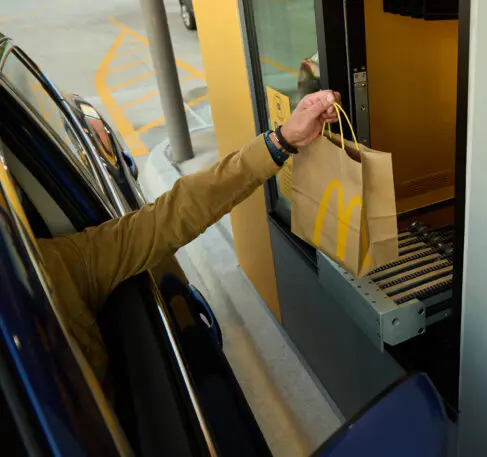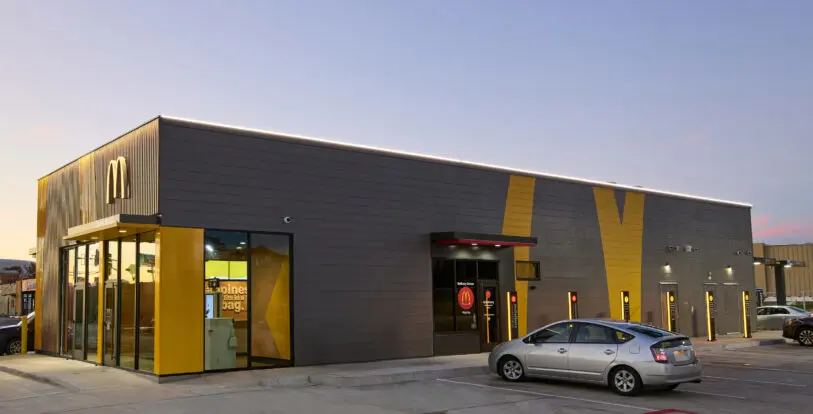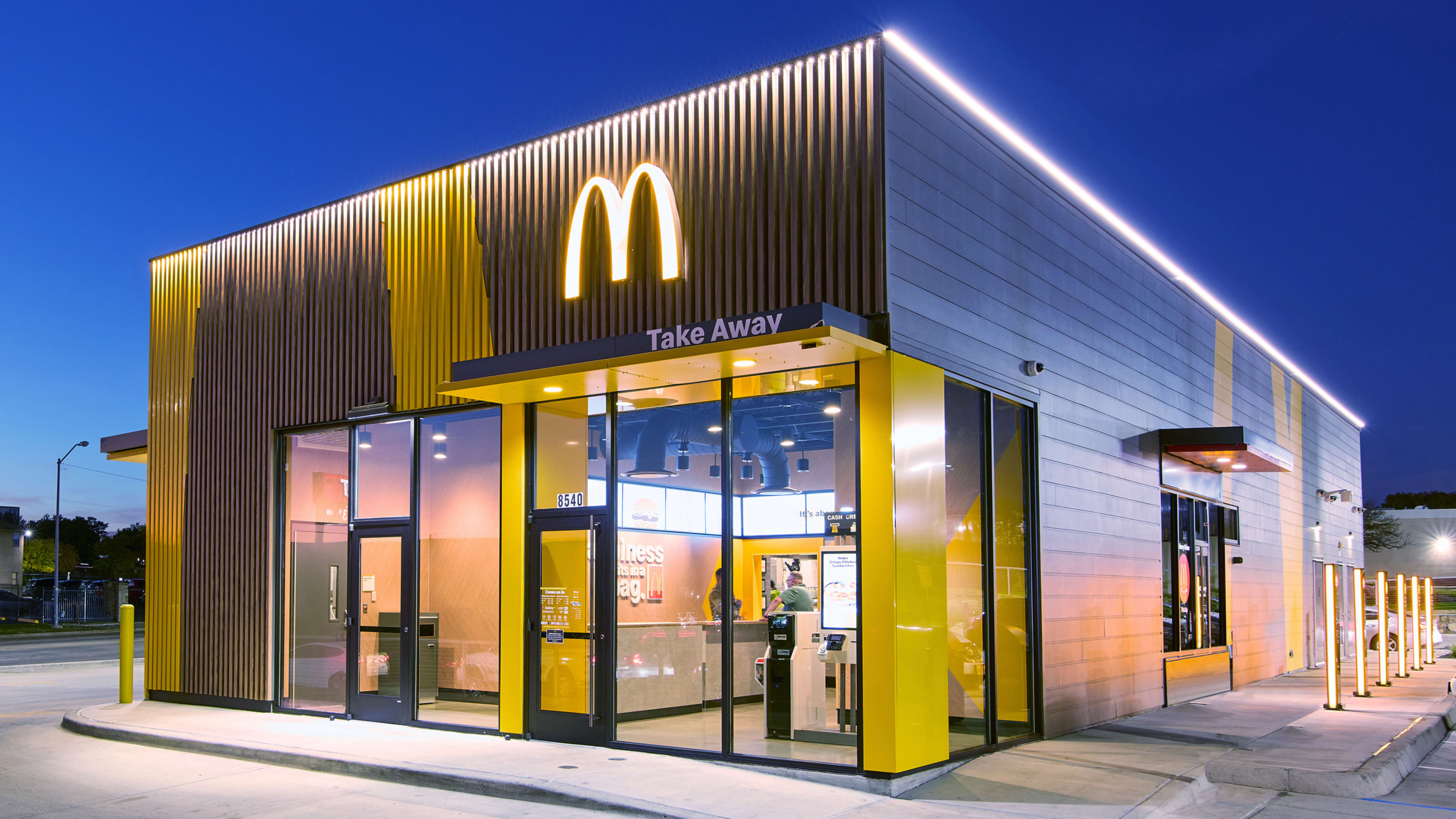Ordering a side of McDonald’s fries just became a little bit easier—if you live near Fort Worth, Texas.
The American fast-food giant has unveiled a digital-only drive-through restaurant with a smaller footprint and zero seating capacity. Designed by branding agency UXUS, the restaurant is 26% smaller than the average McDonald’s joint and combines multiple ways of ordering under one roof: You can pull up at a regular drive-through window and order as you normally do, or you can park and order at the counter inside.
But the brand’s latest innovation is what it calls the “Order Ahead Lane.” This lets you place an order ahead of time, using McDonald’s mobile app, then bypass the regular drive-through lane, which may or may not be taken up by a conga line of cars, and head straight to the other lane, where your order will be served—or rather, rolled out—on a conveyor belt. The restaurant looks a little like a branded storage unit sitting on the side of a road, but this isn’t meant to win a Pritzker Prize. It’s meant to win customers and improve the one thing they came to the drive-through for: convenience.

In Q2 of this year, digital sales (kiosk, app, and delivery orders) accounted for $6 billion, or one-third of McDonald’s sales, across the brand’s top six markets. In the U.S. alone, 25 million customers use the app and the brand’s loyalty program today. “Digital is a primary driver to improve the customer experience, reduce complexity, and drive profitability,” McDonald’s CEO Chris Kempczinski said during the company’s Q3 2022 Earnings Call.
With the test store, McDonald’s is hoping to capitalize on this digital trend, even if the brand is considerably late in the game compared to its competitors. George Gottl, the chief creative officer and cofounder of UXUS, has been working with McDonald’s for more than 10 years. He says that the pandemic changed how people order food, with safety and convenience becoming even bigger priorities for customers. “[McDonald’s was] already anticipating that the younger generation is much more digitally savvy,” he says. “For them, ordering through their mobile device is very natural, so this was a test store to see how it would go.”
When Wendy’s launched its first drive-through restaurant in the 1970s, the concept was so foreign that customers reportedly needed instructions about how to place an order through the speaker. McDonald’s new drive-through experience seems very much like McDonald’s old drive-through experience, albeit with an extra lane, plus a tight integration with the restaurant’s existing digital ordering option. That last bit—creating an effortless ordering and pickup process—is perhaps the new store’s most compelling feature.
To create a seamless experience, UXUS choreographed the various journeys a customer could take into the space. If you’re ordering as usual, you would pull up under a portal, place your order with a member of staff and pick it up at another window around the corner. If you ordered ahead, you would branch out onto the other lane, pull up to a kiosk, confirm your order number over a speaker, and wait for your bag to be dropped off by the conveyor belt. (And if you feel like a luddite who needs a stretch from all the driving, you would park the car and order from a kiosk inside.) These various touchpoints required that the navigation was crystal clear to customers. “Everything about the design is about navigating the space intuitively,” says Gottl.

McDonald’s isn’t the first to experiment with digitally-oriented restaurants, drive-throughs, or even smaller format stores. Starbucks saw the potential for mobile preorders and digital drive-throughs about a decade ago. Chipotle opened its first digital-only restaurant in 2021, in Highland, New York. And even Panera, a staple across rural America, ventured into New York City this year, with two new store formats organized around pick-ups and delivery, with limited counter seating, or no seating whatsoever.

Drive-throughs are particularly ripe for reinvention today. According to a recent Drive-Thru Report surveying 1,000 consumers across ten restaurant chains (including McDonald’s, Chick-fil-A, Dunkin’ and Taco Bell), drive-through times increased by 45 seconds in 2022 compared to 2019. Some fast food chains have sought to improve waiting times by increasing the number of lanes, adding pick-up food lockers (for Burger King and KFC), or delivering orders through vertical “food tubes” (for Taco Bell).
McDonald’s approach is tamer. With its Fort Worth location, McDonald’s is testing the waters in a place where they already have a strong market. (As of now, McDonald’s doesn’t intend to replicate this model elsewhere.) It might not scream innovation and it doesn’t come with a newfangled contraption (unless you think a conveyor belt fits the bill.), but it’s telling that one of the world’s largest fast-food chains is moving in this direction.
With its move into digital, McDonald’s is also testing new technology that allows the restaurant staff to track your arrival time through the app and only start preparing your order when you are near the restaurant. “It’s because of the obsession with freshness,” says Gottl. Yes, it feels a bit stalkerish, but the upside? At least your fries won’t get soggy if you get stuck in traffic.
Recognize your brand’s excellence by applying to this year’s Brands That Matter Awards before the early-rate deadline, May 3.
